Management and Control of Agricultural Production Space in the Yanhe River Basin Based on Peasant Household Behavior
Abstract
1. Introduction
2. Materials and Methods
2.1. Study Area
2.2. Data Sources
2.3. Research Methods
2.3.1. Land Use Dynamic Change Index
2.3.2. Average Center of Gravity of Geographical Distribution
2.3.3. Landscape Pattern Index Method
2.3.4. Subwatershed Division
2.3.5. Zoning Evaluation Model
2.3.6. Production Function Suitability Evaluation
3. Results
3.1. Characteristics of Peasant Household Behavior Changes and Agricultural Production Space Evolution
3.1.1. Spatial Scale Volatility Decrease: Transformation of Peasant Household Land Management Behavior under Urbanization
3.1.2. Shift in the Gravitational Center of Spatial Distribution: Change in Production Input with Transformations in Development Conditions
3.1.3. Spatial Form from Fragmented to Regular: Increase and Decrease in Peasant Household Labor Input under Multiple Factors
3.1.4. Relationship between Peasant Household Behavior Changes and Agricultural Production Space Evolution
3.2. Characteristics of Peasant Household Behavior Changes and Agricultural Production Space Evolution
3.2.1. Management and Control Basis—Grading and Classification
- Zoning of spatial advantages in agricultural production.
- 2.
- Rural classification
3.2.2. Management and Control Implementation—Strategy Guidance
Adjust Cultivated Land Form
- The type of cultivated land that is distributed along the strips mainly creates efficient industrial space through land replacement, large-scale operation, and undertaking water sources.
- The form of circular cultivated land in which cultivated land is concentrated around residential areas is more suitable for merging plots according to the terrain, shortening the distance between peasant household plots, facilitating farming and the management of peasant households, and promoting intensive management.
- For more complex cultivated land forms, the adjustment of land plots is carried out according to the cultivated land’s topographical conditions. Linear staggered roads and arable land are more convenient for mechanized management and peasant household cultivation.
Improve Production Support
3.2.3. Management and Control Guarantee—Policies and Regulations
4. Discussion
5. Conclusions
- Due to the transformation of peasant household land management behavior under urbanization, the change in production input brought about by changes in development conditions, and the increase or decrease in peasant household labor input under multiple factors, the agricultural production space in the Yanhe River Basin presents three major evolutionary characteristics: a reduced fluctuation in spatial scale, a downstream shift in the center of gravity of spatial distribution, and a transformation of the spatial form from fragmented to regular.
- Production input behavior and production and management behavior will have a direct impact on the selection of crop species planted in agricultural space, the direction of production development, and the layout of production space. Therefore, the peasant household’s production and management behavior and production input behavior are the dominant drivers of the Yanhe River Basin’s agricultural production space evolution. Resource utilization behavior is the impact on the production space after peasant households use external assistance to improve their own agricultural production behavior, which is the external driving factor.
- Based on the impact of peasant household behavior on agricultural production space evolution, our study regulates peasant household behavior decision-making and guides the optimization of the agricultural production structure according to the grading and classification of the “management and control basis + management and control implementation + management and control guarantee” control method system. From the two aspects of improving production infrastructure support and adjusting the form of cultivated land, the implementation of control measures has been promoted. From the two levels of macro-policy constraints and micro-awareness guidance, the effective implementation of management and control is guaranteed.
Author Contributions
Funding
Institutional Review Board Statement
Informed Consent Statement
Data Availability Statement
Acknowledgments
Conflicts of Interest
References
- Liu, Y. Research on the urban-rural integration and rural revitalization in the new era in China. Acta Geogr. Sin. 2018, 73, 637–650. [Google Scholar]
- Qian, F.K.; Chi, Y.R.; Lal, R. Spatiotemporal characteristics analysis of multifunctional cultivated land: A case-study in Shenyang, Northeast China. Land Degrad. Dev. 2020, 31, 1812–1822. [Google Scholar] [CrossRef]
- Wang, C.; Li, H. Conceptual and research frameworks of rural production space system. Prog. Geogr. 2017, 36, 913–923. [Google Scholar]
- Teshome, D.S.; Moisa, M.B.; Gemeda, D.O.; You, S.C. Effect of Land Use-Land Cover Change on Soil Erosion and Sediment Yield in Muger Sub-Basin, Upper Blue Nile Basin, Ethiopia. Land 2022, 11, 2173. [Google Scholar] [CrossRef]
- Arunrat, N.; Sereenonchai, S.; Kongsurakan, P.; Hatano, R. Soil organic carbon and soil erodibility response to various land-use changes in northern Thailand. Catena 2022, 219, 106595. [Google Scholar] [CrossRef]
- Arunrat, N.; Sereenonchai, S.; Kongsurakan, P.; Iwai, C.B.; Yuttitham, M.; Hatano, R. Post-fire recovery of soil organic carbon, soil total nitrogen, soil nutrients, and soil erodibility in rotational shifting cultivation in Northern Thailand. Front. Environ. Sci. 2023, 11, 1117427. [Google Scholar] [CrossRef]
- Lv, J.; Yang, B.D.; Yang, Y.J.; Zhang, Z.H.; Chen, F.; Liu, G.J. Spatial Patterns of China’s Major Cities and Their Evolution Mechanisms during the Past Decades of Reform and Opening Up. Procedia Eng. 2017, 198, 915–925. [Google Scholar] [CrossRef]
- Hui, A. Research on the Management Pattern of Small Watershed Treatment in Loess Plateau Region. Adv. Mater. Res. 2013, 664, 117–122. [Google Scholar]
- Wen, X.Y.; Liu, T.T.; Tao, S.J. Discussion on the management and control strategy of production-living ecological space based on humanistic needs: Take Honghe Prefecture of Yunnan Province as an example. Shanghai L. Resour. 2022, 43, 49–54, 85. [Google Scholar]
- Liu, Y.S.; Wang, Z.Y.; Qu, Y. Construction of Ecological Spatial Control System Based on Ecosystem Services Measurement. Chin. Landsc. Archit. 2019, 35, 77–82. [Google Scholar]
- Zhai, D.Q. From Space Conflict to Space Integration: Territorial Space Management Optimization and Planning Response from the Perspective of Man-Land Coupling. City Plan. Rev. 2022, 46, 7–17. [Google Scholar]
- Geng, H.Z.; Li, K.M. The Regulation of Whole Rural Space under the Territory Development Planning System Analysis Based on Shanghai’s Experience. Urban Plan. Forum 2020, 4, 58–66. [Google Scholar]
- Guo, X.L.; Qu, X.Q.; Sun, L. Study on ecological spatial pattern of Qingdao from the perspective of territorial spatial planning. J. Qingdao Technol. Univ. 2022, 43, 79–87. [Google Scholar]
- Fang, F.; He, R.W. A study on the characteristics and mechanisms of the spatial evolution of rural three lives from the perspective of farmer behavior. Learn. Pract. 2018, 1, 101–110. [Google Scholar]
- Jiang, G.; He, X.; Ma, W.; Wang, M.; Zhang, R. Rural settlements spatial pattern evolution and zoning district based on spatial autocorrelation. Trans. Chin. Soc. Agric. Eng. 2015, 31, 265–273. [Google Scholar]
- Chen, Q.; Yang, J. The Analysis of Peasant Households’ Farmland Utilization Behavior and Influencing Factors of Fujian Forest Region under the Perspective of Carbon Emissions. Ecol. Econ. 2018, 34, 33–37. [Google Scholar]
- Xie, H.L.; Wang, P.; Yao, G.R. Exploring the Dynamic Mechanisms of Farmland Abandonment Based on a Spatially Explicit Economic Model for Environmental Sustainability: A Case Study in Jiangxi Province, China. Sustainability 2014, 6, 1260–1282. [Google Scholar] [CrossRef]
- Zhang, X.B.; de Vries, W.T.; Li, G.; Ye, Y.M.; Zheng, H.Y.; Wang, M.R. A behavioral analysis of farmers during land reallocation processes of land consolidation in China: Insights from Guangxi and Shandong provinces. Land Use Policy 2019, 89, 104230. [Google Scholar] [CrossRef]
- Fu, J.J.; Wu, L. The behavior of peasant household land mobility factors affecting the empirical analysis based on the Heilongjiang Province ningan investigation. Contemp. Rural Financ. Econ. 2019, 1, 2–8. [Google Scholar]
- Zhao, J.J.; Liu, L.Z.; Qi, J.L.; Dong, J.P. Study on the influence of environmental regulation on the environmentally friendly behavior of farmers in China. Front. Environ. Sci 2022, 10, 1009151. [Google Scholar] [CrossRef]
- Wang, Y.; Liu, J.; Xue, H.; Tan, Z. Rural Plan Implementation Based on Land Property Rights Innovation: A Case Study of Qinggangshu Village in Chengdu. China City Plan. Rev. 2018, 27, 34–41. [Google Scholar]
- Chen, Y.S.; Chen, B.M.; Luo, R.J.; Yao, S.H.; Yao, D.Q. An Analysis on the Peasant Household’s Behavior in the Utilizing Process of Natural Resources in Plowland-scarcity Regions—Taking Shexian County, Anhui Province as the Example. Acta Agric. Univ. Jiangxiensis (Nat. Sci. Edn.) 2005, 6, 943–948. [Google Scholar]
- Mu, X.M.; Wang, S.Y.; Gao, P.; Wang, W. Temporal Change Analysis of Hydrological Factors in the Yanhe River Basin. Bull. Soil Water Conserv. 2005, 1, 11–14. [Google Scholar]
- Zhang, H.T.; Guo, L.; Chen, J.Y.; Fu, P.H.; Gu, J.L.; Liao, G.Y. Modeling of Spatial Distributions of Farmland Density and Its Temporal Change Using Geographically Weighted Regression Model. Chin. Geogr. Sci. 2014, 24, 191–204. [Google Scholar] [CrossRef]
- Chen, L.; Wang, Q. Study on the Contradiction between Population and Cultivated Land and the Priority Protection of Cultivated Land in the Policy of Poverty Alleviation: A Case Study of the Upper Reaches of Min River, Sichuan Province, China. Sustainability 2021, 13, 3348. [Google Scholar] [CrossRef]
- Su, D.S.; Ling, Z.; Long, X.T. Awareness of farmer organizations cultivation and rural NGOs development. Econ. Res. Guid. 2010, 34, 52–55. [Google Scholar]
- Guo, G.C.; Wen, Q.Y.; Zhu, J.J. The Impact of Aging Agricultural Labor Population on Farmland Output: From the Perspective of Farmer Preferences. Math. Probl. Eng. 2015, 2015, 7830618. [Google Scholar] [CrossRef]
- Gan, Z.M.; Yue, D.P.; Gan, R. Distribution and land use characteristics of rural settlements in loess hilly and gully areas of northern Shaanxi. J. Shaanxi Norm. Univ. 2004, 3, 102–106. [Google Scholar]
- Wan, Q.; Wang, C.; Du, X. Redefinition of patterns of production space on village scale based on evaluation of the land scale operation conditions for Dazhu Village, Chongqing. Resour. Sci. 2016, 38, 387–394. [Google Scholar]
- He, Y.Z.; Wang, C. The evolution and sustainable development capacity of rural production space system based on information entropy. J. Nat. Resour. 2019, 34, 815–828. [Google Scholar] [CrossRef]
- Wu, L.; Luo, J.; Li, M. Evaluation method of land-scaled consolidation potential based on landscape pattern principle. Trans. Chin. Soc. Agric. Eng. 2010, 26, 300–306. [Google Scholar]
- Jia, Y.Q.; Tang, L.N.; Xu, M.; Yang, X.Y. Landscape pattern indices for evaluating urban spatial morphology—A case study of Chinese cities. Ecol. Indic. 2019, 99, 27–37. [Google Scholar] [CrossRef]
- He, S.W.; Yu, S.; Li, G.D.; Zhang, J.F. Exploring the influence of urban form on land-use efficiency from a spatiotemporal heterogeneity perspective: Evidence from 336 Chinese cities. Land Use Policy 2020, 95, 104576. [Google Scholar] [CrossRef]
- Beisel, J.-N.; Moreteau, J.-C. A simple formula for calculating the lower limit of Shannon’s diversity index. Ecol. Modell. 1997, 99, 289–292. [Google Scholar] [CrossRef]
- Bui, M.T.; Lu, J.; Nie, L. Evaluating the effects of watershed subdivision on hydrological simulation by Swat model in an arctic watershed. Earth Environ. Sci. 2020, 581, 012026. [Google Scholar] [CrossRef]
- Chen, M.X.; Lu, D.D.; Zhang, H. Comprehensive Evaluation and the Driving Factors of China’s Urbanization. Acta Geogr. Sin. 2009, 64, 387–398. [Google Scholar]
- He, Y.Z.; Wang, C. Evaluation and Pattern Optimization of Rural Production Space System Function: A Case Study of Banan District, Chongqing Municipality. Econ. Geogr. 2019, 39, 162–171. [Google Scholar]
- Everest, B. Farmers’ adaptation to climate-smart agriculture (CSA) in NW Turkey. Environ. Dev. Sustain. 2021, 23, 4215–4235. [Google Scholar] [CrossRef]
- Guo, H.P.; Xu, S.; Wang, X.T.; Shu, W.; Chen, J.; Pan, C.L.; Guo, C. Driving Mechanism of Farmers’ Utilization Behaviors of Straw Resources—An Empirical Study in Jilin Province, the Main Grain Producing Region in the Northeast Part of China. Sustainability 2021, 13, 2506. [Google Scholar] [CrossRef]
- Everest, B. Farmers’ adaptations of soil and water conservation in mitigating climate change. Arab. J. Geosci. 2021, 14, 142141. [Google Scholar] [CrossRef]
- Fang, Y. Research on the use of requlation rules for zoning and classification of territorial space. Shanghai L. Resour. 2023, 44, 10–14. [Google Scholar]
- Zhao, Y.J.; Liang, R.M.; Ding, A.Z.; Lan, W.L. Differences in the influence of landscape features on river water quality at different spatial scales. Acta Ecol. Sin. 2023, 43, 1–11. [Google Scholar]
- Getahun, Y.S.; Gebremedhn, A.Y.; Lemma, E.; Tesfay, F.; Tadesse, S.A. Surface irrigation potential assessment of Chacha River Watershed, Jemma subbasin of upper Blue Nile, Ethiopia. Front. Environ. Sci. 2023, 11, 1129716. [Google Scholar] [CrossRef]
- Li, H.B.; Yuan, Y.; Zhang, X.L.; Li, Z.; Wang, Y.H.; Hu, X.L. Evolution and transformation mechanism of the spatial structure of rural settlements from the perspective of long-term economic and social change: A case study of the Sunan region, China. J. Rural Stud. 2019, 93, 234–243. [Google Scholar] [CrossRef]
- Pan, Y.X.; Yang, R.; Lin, Y.C. Evolution of spatial resource and environment carrying capacity and suitability of agricultural production in China and its coupling mechanism. China Land Sci. 2023, 37, 20–31. [Google Scholar]
- Li, S.N.; Zhao, X.Q.; Pu, J.W.; Miao, P.P.; Wang, Q.; Tan, K. Optimize and control territorial spatial functional areas to improve the ecological stability and total environment in karst areas of Southwest China. Land Use Policy 2021, 100, 104940. [Google Scholar] [CrossRef]
- Ge, D.Z.; Lu, Y.Q. A strategy of the rural governance for territorial spatial planning in China. J. Geogr. Sci. 2021, 31, 1349–1364. [Google Scholar] [CrossRef]


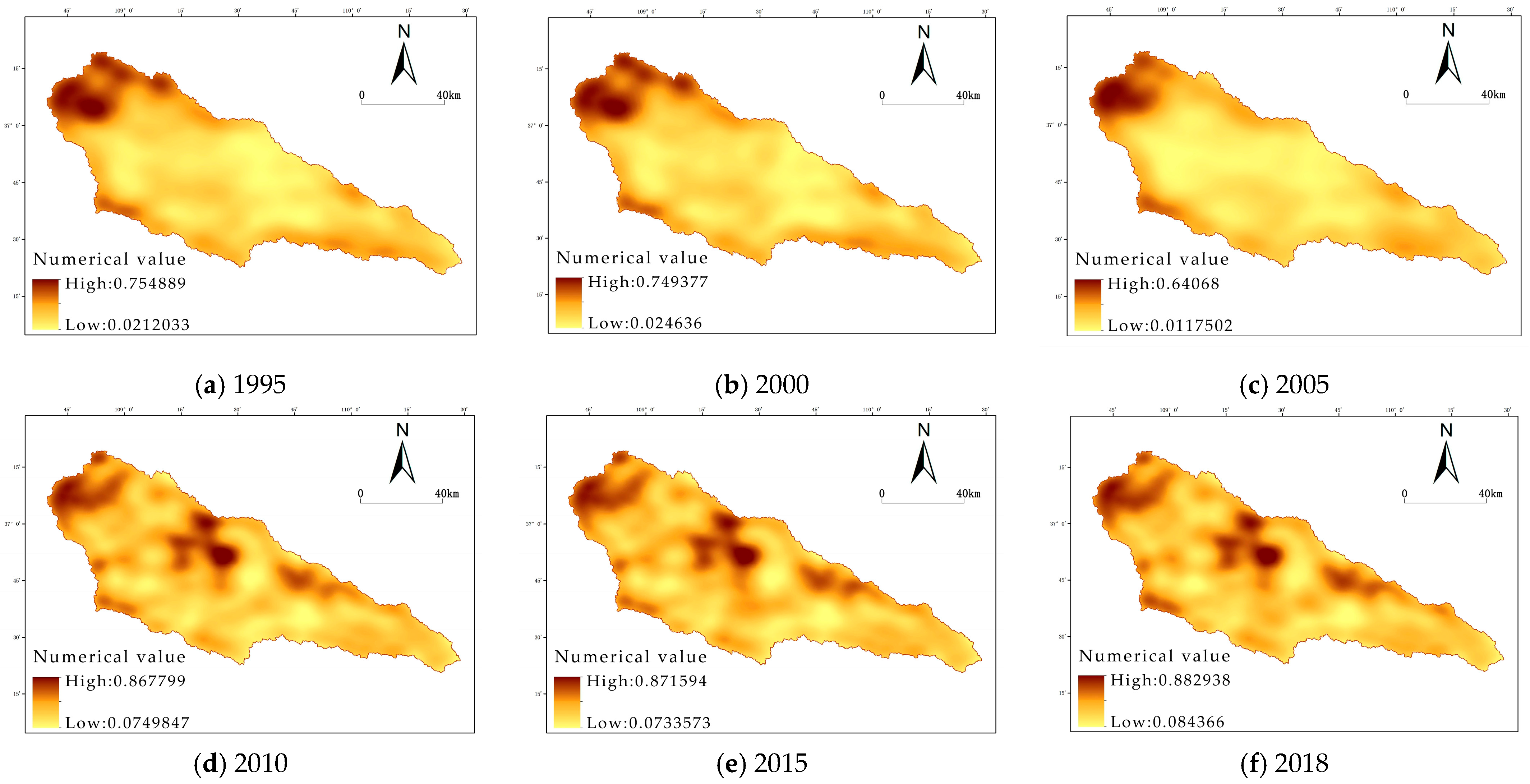
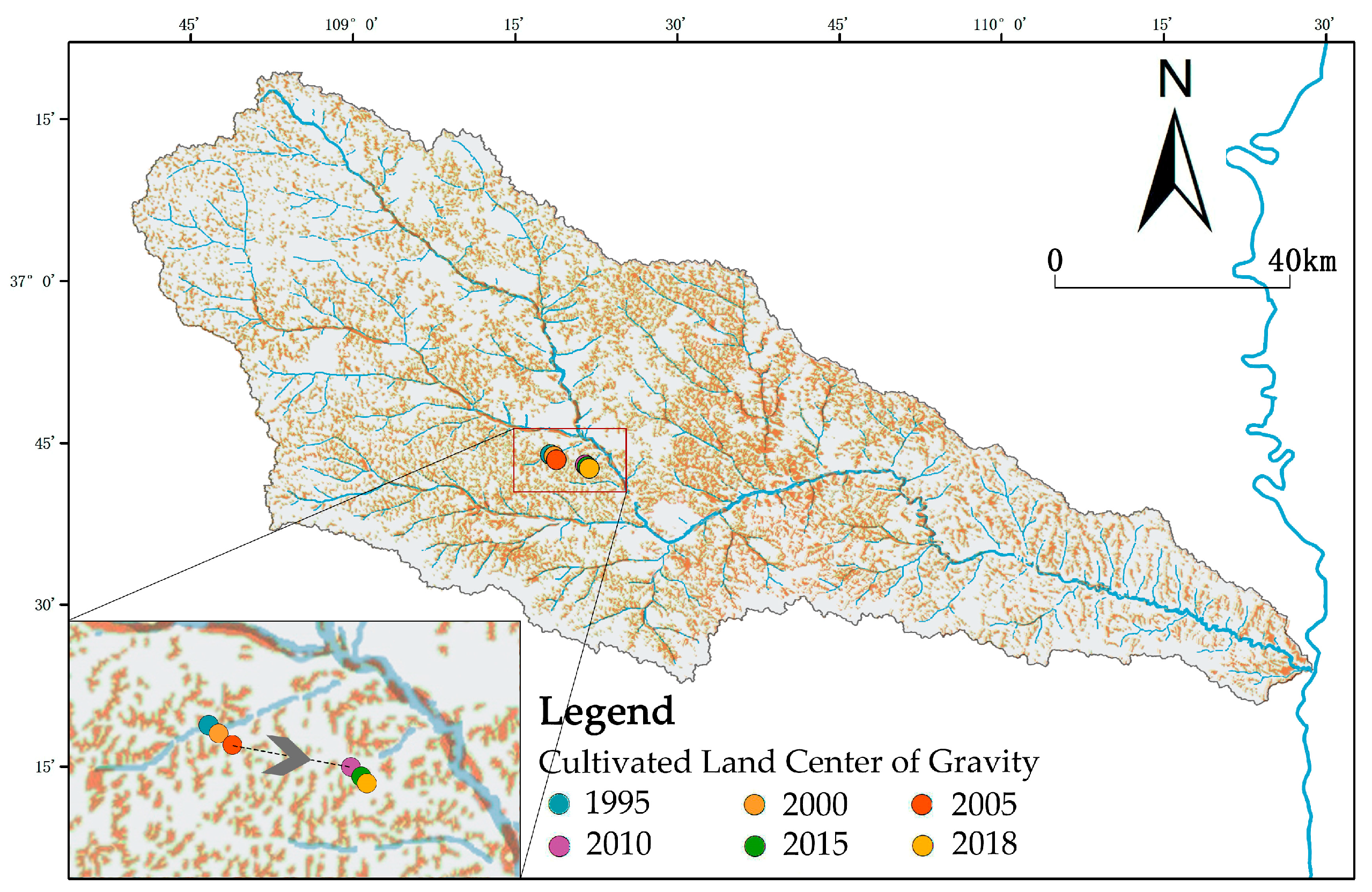
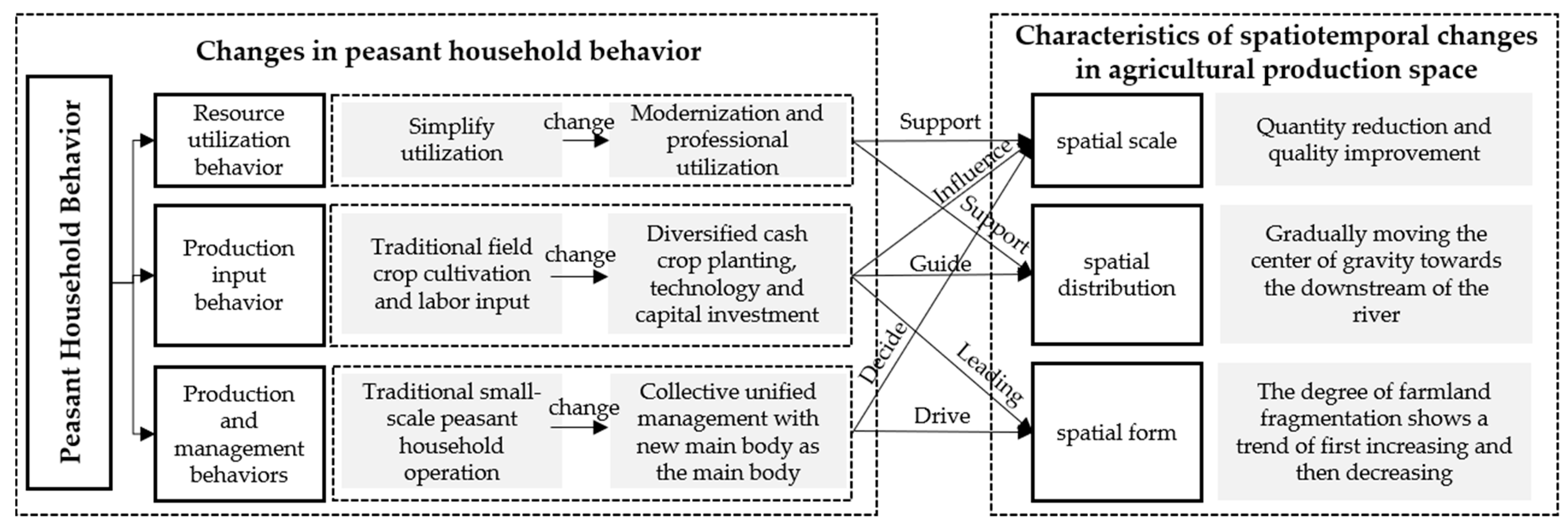
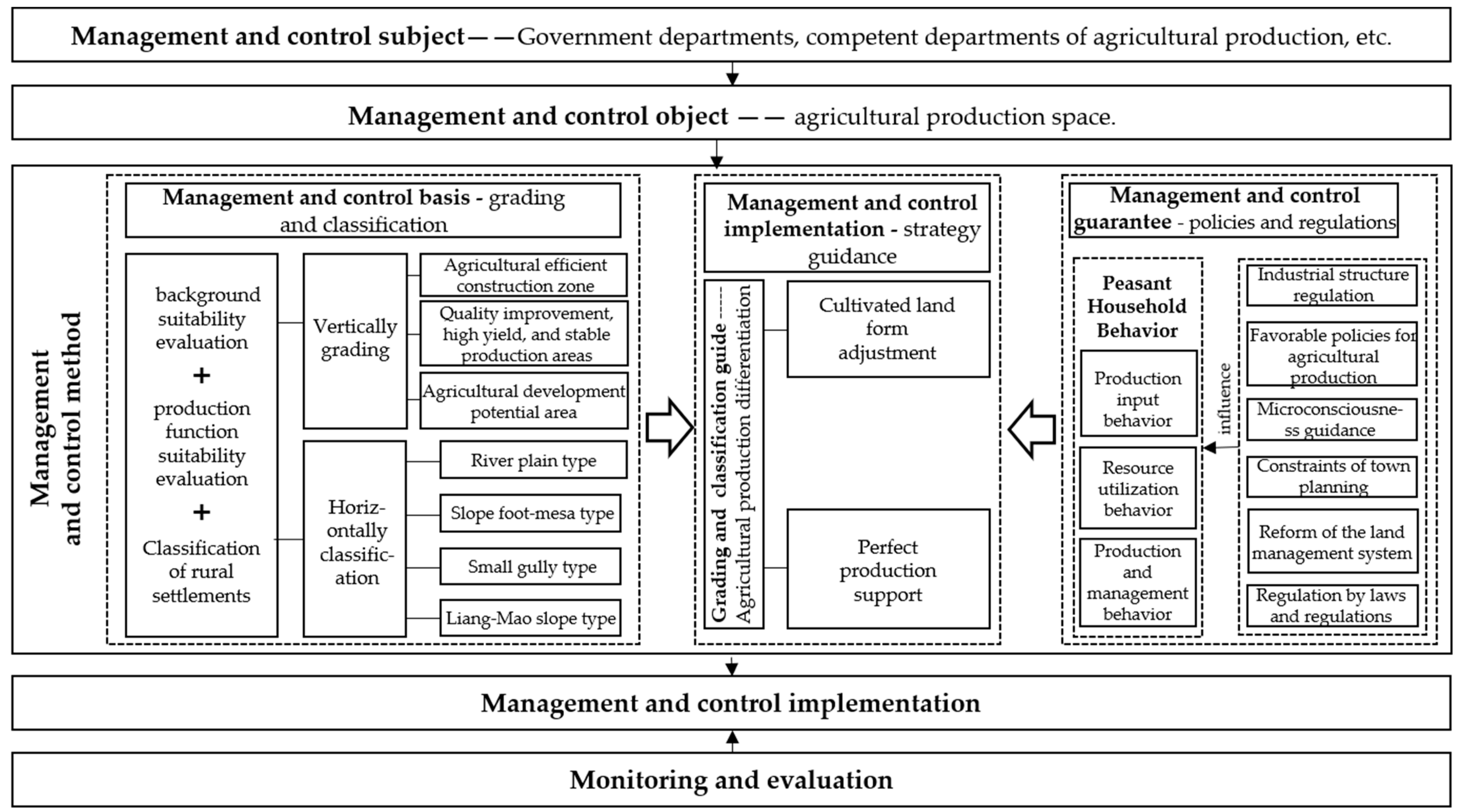

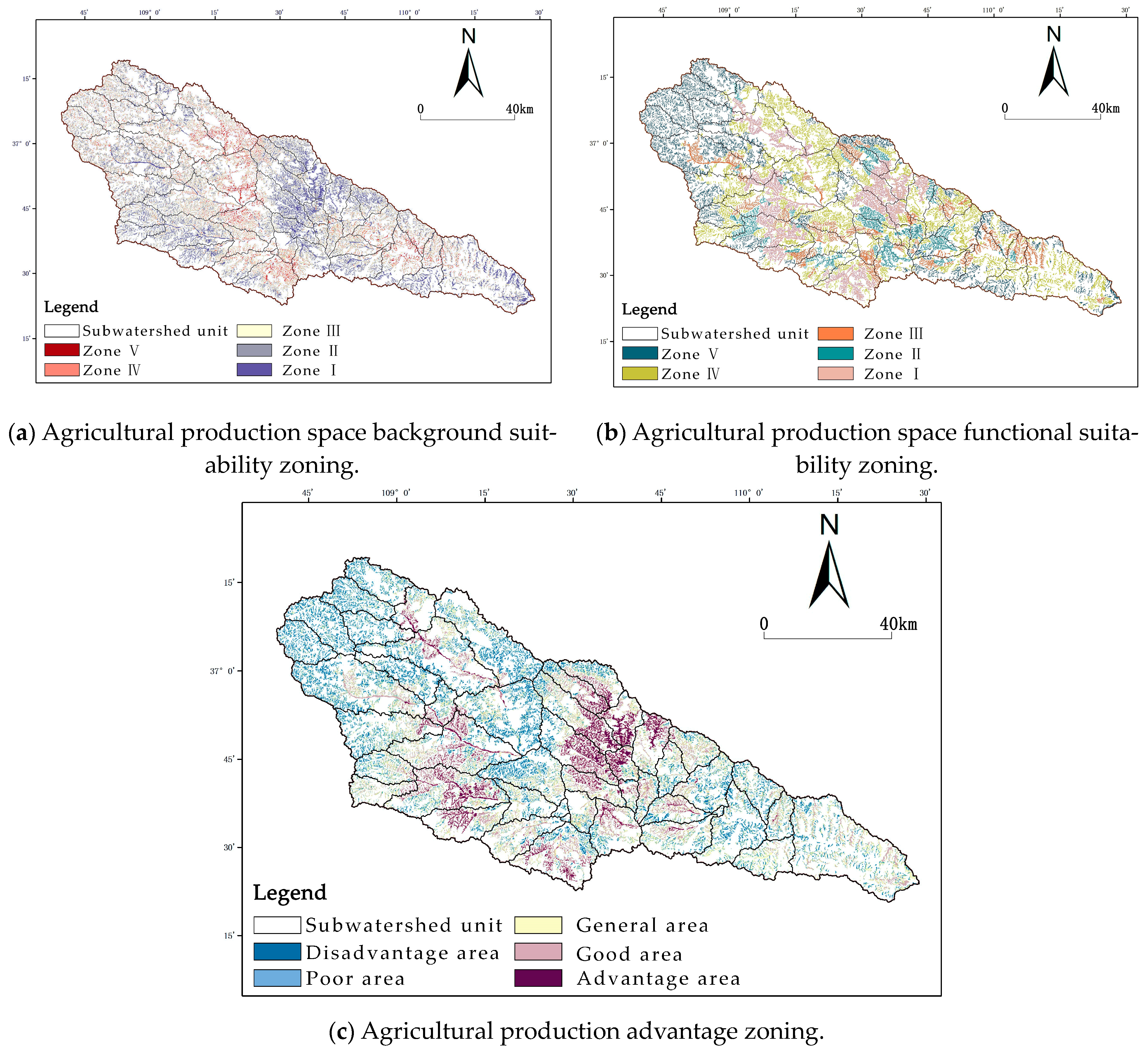

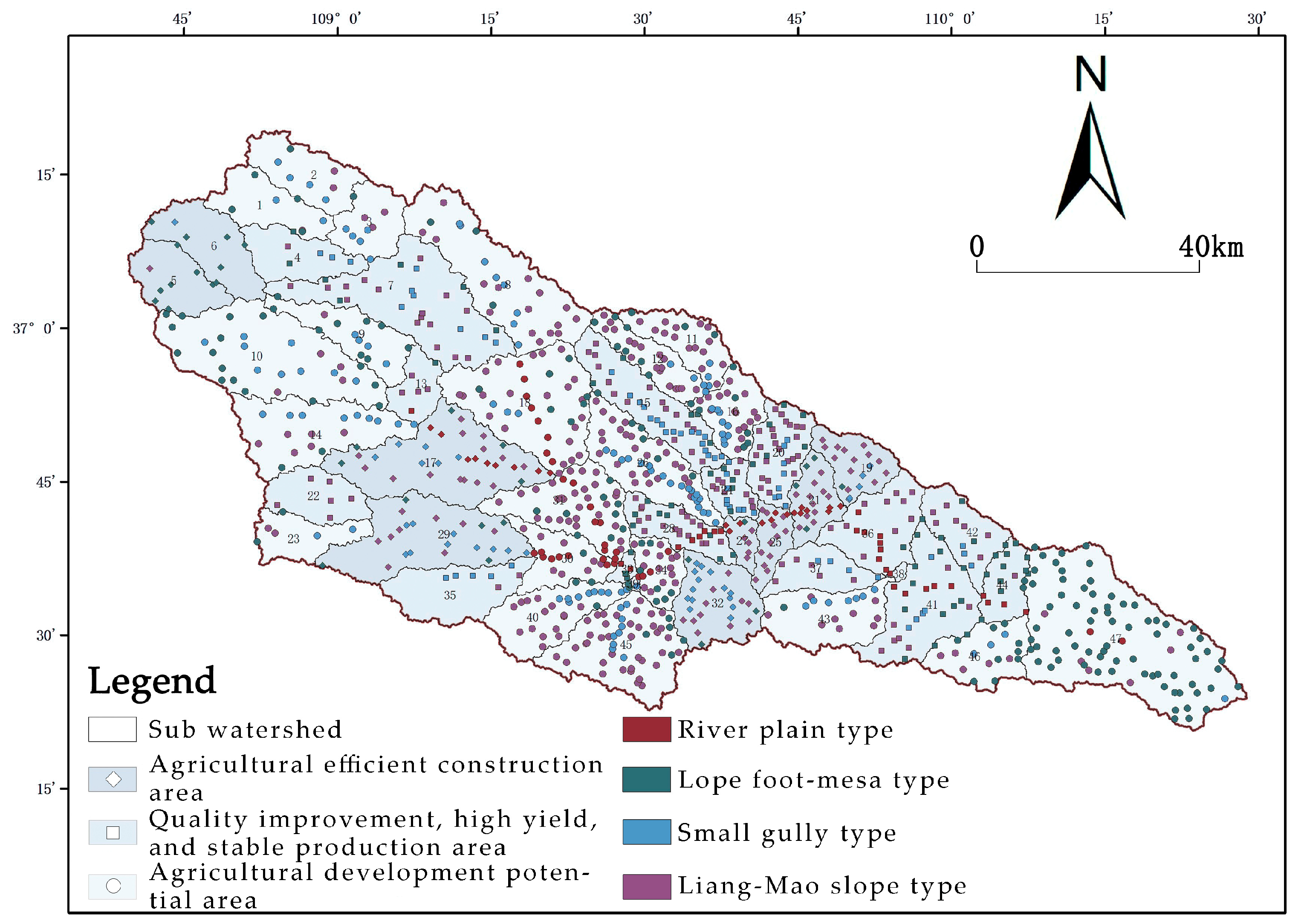
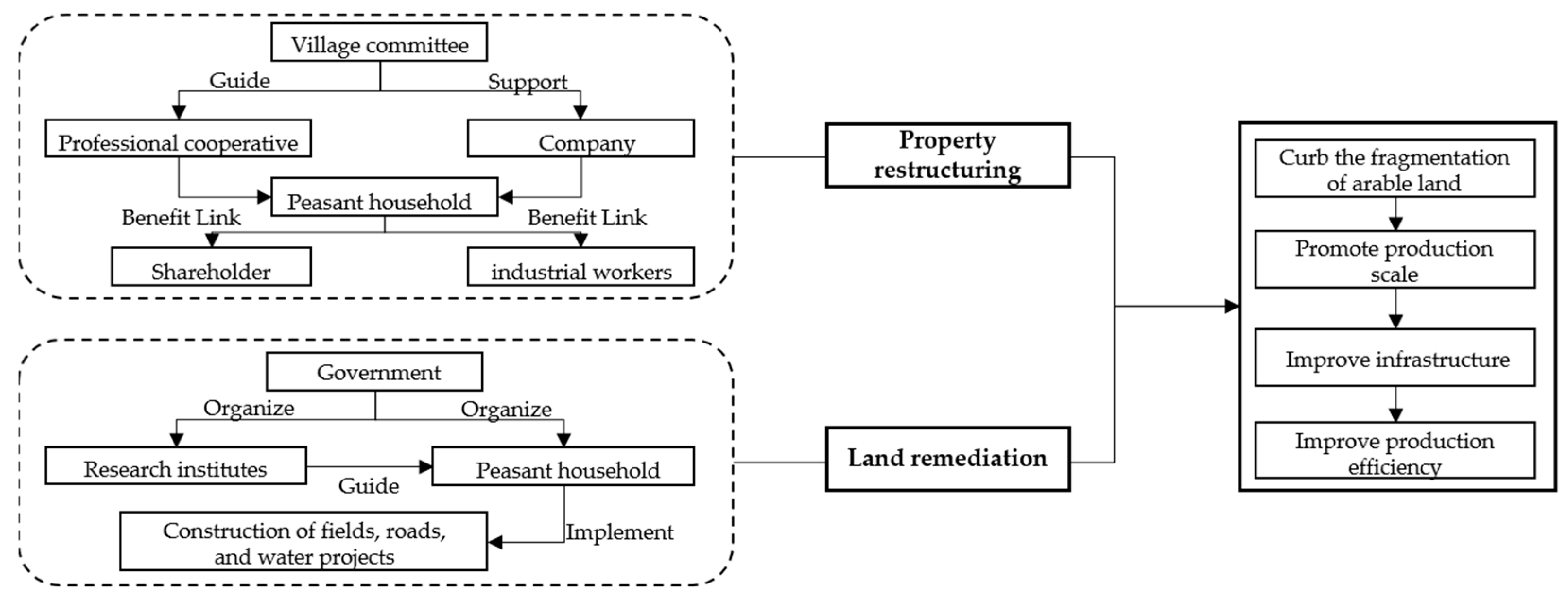
| Index Type | Patch Indicators | Formula | Formula Explanation | Indicator Significance |
|---|---|---|---|---|
| Area | Number of Patches (NP) | NP = N | N is the number of patches | The higher the value, the higher the degree of fragmentation of cultivated land |
| Mean Patch Size (MPS) | A is the total area of patches; N is the number of patches | The most direct indicator reflecting patch size. The higher the value, the lower the degree of fragmentation | ||
| Shape | Mean Shape Index (MSI) | represents the circumference of the th patch of the ith patch type, and is the area of the jth patch of the ith patch type; n is the number of patches | The larger the value, the higher the complexity of the plaque | |
| Perimeter Area Fractal Dimension (PAFRAC) | P represents the perimeter of the patch; A represents the area of the patch | The larger the value, the more complex the shape of the patch | ||
| Diversity | Shannon Diversity Index (SHDI) | represents the proportion occupied by landscape patch type | It reflects spatial heterogeneity: the larger the index, the higher the fragmentation degree |
| Year | Cultivated Land Area (km2) | Cultivated Land Change Area (km2) | Annual Change Rate of Cultivated Land Area (%) |
|---|---|---|---|
| 1995 | 3330.07 | — | — |
| 2000 | 3310.81 | −19.26 | −0.58 |
| 2005 | 3094.37 | −216.44 | −6.54 |
| 2010 | 2442.39 | −651.99 | −21.07 |
| 2015 | 2428.12 | −14.27 | −0.58 |
| 2018 | 2403.22 | −24.90 | −1.03 |
| Year | Number of Patches (NP) | Mean Patch Size (MPS) | Mean Shape Index (MSI) | Perimeter Area Fractal Dimension (PAFRAC) | Shannon Diversity Index (SHDI) |
|---|---|---|---|---|---|
| 1995 | 5375 | 143.02 | 2.43 | 1.55 | 1.41 |
| 2000 | 5454 | 140.94 | 2.45 | 1.55 | 1.43 |
| 2005 | 5489 | 140.05 | 2.53 | 1.58 | 1.54 |
| 2010 | 8540 | 90.01 | 2.41 | 1.59 | 1.63 |
| 2015 | 8771 | 87.64 | 2.40 | 1.57 | 1.66 |
| 2018 | 8348 | 92.08 | 2.41 | 1.58 | 1.63 |
| Target Layer | Production Space Partition | Weight | ||||
|---|---|---|---|---|---|---|
| Favorable Region | More Suitable Region | General Region | Less Suitable Region | Unsuitable Area | ||
| Slope | 0–2 | 2–6 | 6–15 | 15–25 | >25 | 0.30 |
| Slope type | −0.2–0.2 | −0.5–−0.2; 0.2–0.5 | −0.5–−1; 0.5–1 | −1–−2; 1–2 | <−2; >2 | 0.21 |
| Disaster density | Distance from river | 0.21 | ||||
| Soil type | Yellow loamy soil | Dack loessial soil, red clay | Rhogosol | Alluvial soil | Lake | 0.12 |
| Rainfall | Distance from river | 0.10 | ||||
| Distance from river | 0–500 m | 500–1000 m | 1000–1500 m | 1500–2000 m | >2000 m | 0.06 |
| Assignment | 1.00 | |||||
| Partition | Control Strategy | Rural Type | Development Guidance |
|---|---|---|---|
| Agriculturally efficient construction area |
| River plain type | Modern urban agriculture development driven by cities and towns |
| Slope foot–mesa type | Develop leisure agriculture and modern agriculture | ||
| Small gully type | Develop tourism agriculture and efficient agriculture | ||
| Liang–Mao slope type | Develop modern science and technology agriculture | ||
| Quality improvement, high yield, and stable production area |
| River plain type | Strengthen regional ties and develop modern agriculture |
| Slope foot–mesa type | Strengthen urban–rural ties and develop specialized agriculture | ||
| Small gully type | Specialized organization and develop special agriculture | ||
| Liang–Mao slope type | Joint construction; develop modern agriculture | ||
| Agricultural development potential area |
| River plain type | Support and develop urban agriculture |
| Slope foot–mesa type | Support and develop ecological agriculture and special agriculture | ||
| Small gully type | Develop ecological agriculture and special agriculture | ||
| Liang–Mao slope type | Develop ecology and cultivate modern agriculture |
| Morphological Type | Many Striped and Blocky Spaces | Many Blocky and Annular Spaces | Mixture of Striped, Blocky, and Annular Spaces |
| Examples | 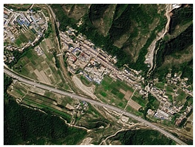 |  | 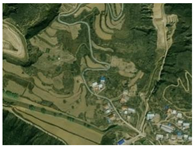 |
| Morphological adjustment mode |  |  |  |
| Category of Agricultural Infrastructure | Agricultural Infrastructure | Configuration Guidelines |
|---|---|---|
| Agricultural leisure service | Agricultural demonstration park | Set up according to the characteristic agricultural industry, with a certain scale, accurate functional positioning, attention to supervision, and standardized development |
| Farm experience park, picking park | Set up according to market size | |
| Farmland water conservancy project | Rainwater collection point | Conform to the basin water conservancy planning and water resource carrying capacity, with an irrigation design guarantee rate of 50–75% |
| Irrigation canal | ||
| Agricultural science and technology service | Agricultural technology training station | Set up in conjunction with important facility points of district and county governments, town governments, and agricultural units |
| Agricultural research base | Set up according to technical conditions | |
| Agricultural information service | Agricultural information station | The location of district and county governments, town governments, and important facility points in agricultural units can be configured, and villages can be set according to their needs |
| Agricultural machinery service | Farm machinery repair station | The location of district and county governments, town governments, and important facility points in agricultural units can be configured |
| Agricultural materials service | Agricultural supply sales station | Set up according to market demand |
| Agricultural logistics service | Agricultural product logistics center | Set up according to market size |
| Agricultural product storage center | Set up according to market size, combined with the setting of agricultural product storage centers |
Disclaimer/Publisher’s Note: The statements, opinions and data contained in all publications are solely those of the individual author(s) and contributor(s) and not of MDPI and/or the editor(s). MDPI and/or the editor(s) disclaim responsibility for any injury to people or property resulting from any ideas, methods, instructions or products referred to in the content. |
© 2023 by the authors. Licensee MDPI, Basel, Switzerland. This article is an open access article distributed under the terms and conditions of the Creative Commons Attribution (CC BY) license (https://creativecommons.org/licenses/by/4.0/).
Share and Cite
Hou, Q.; Chen, S.; Miao, Y.; Zhang, Y.; Chen, S.; Fan, X.; Duan, Y.; Zhang, L. Management and Control of Agricultural Production Space in the Yanhe River Basin Based on Peasant Household Behavior. Sustainability 2023, 15, 8399. https://doi.org/10.3390/su15108399
Hou Q, Chen S, Miao Y, Zhang Y, Chen S, Fan X, Duan Y, Zhang L. Management and Control of Agricultural Production Space in the Yanhe River Basin Based on Peasant Household Behavior. Sustainability. 2023; 15(10):8399. https://doi.org/10.3390/su15108399
Chicago/Turabian StyleHou, Quanhua, Shihan Chen, Yitong Miao, Yahui Zhang, Su Chen, Xiaoyang Fan, Yaqiong Duan, and Lingda Zhang. 2023. "Management and Control of Agricultural Production Space in the Yanhe River Basin Based on Peasant Household Behavior" Sustainability 15, no. 10: 8399. https://doi.org/10.3390/su15108399
APA StyleHou, Q., Chen, S., Miao, Y., Zhang, Y., Chen, S., Fan, X., Duan, Y., & Zhang, L. (2023). Management and Control of Agricultural Production Space in the Yanhe River Basin Based on Peasant Household Behavior. Sustainability, 15(10), 8399. https://doi.org/10.3390/su15108399







